Specialized Turbo Levo Comp Alloy
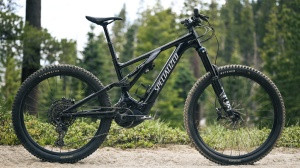 Specialized Turbo Levo Comp Alloy best overall e-MTB for trail riding and adjustable geometry
Specialized Turbo Levo Comp Alloy best overall e-MTB for trail riding and adjustable geometry
87
OVERALL SCORE
- Downhill Performance 9.0
- Climbing Performance 8.0
- Measured Effective Range 9.0
- Power Output 9.0
- E-Bike Controls 7.0
REASONS TO BUY
700Wh battery
Highly adjustable geometry
Intuitive operation
Excellent range
REASONS TO AVOID
Should come stock with tougher casing tires
Non-e-bike-specific fork
Code R brakes are underpowered
No longer winning the battery size wars
SPECIFICATIONS
| Wheel size (inches) | MX (29″ front, 27.5″ rear) |
|---|---|
| Battery Size (Wh) | 700Wh |
| Motor System | Specialized Turbo Full Power 2.2 |
| Motor Power (torque) | 90Nm |
| Measured Weight (w/o pedals) | 51 lbs 3 oz (S4) |
The Specialized Turbo Levo Comp Alloy secures the top position for the fourth consecutive year as the best overall electric mountain bike. According to lead tester Joshua Hutchens, “It’s just the most fun to ride.” A standout feature is its adjustable geometry, offering six distinct configurations via adjustable headset cups and chainstay flip chips. The head cups allow head tube angle adjustments in full-degree increments between 65.5 and 63.5 degrees, while the flip chips modify the bottom bracket height by 7mm between high and low settings. Joshua notes, “This unprecedented adjustability lets riders tailor the bike to their riding style, terrain, and preferences, enhancing the Levo’s versatility.” The mixed wheel size setup improves rear-end maneuverability and clearance on steep trails. The 700Wh battery, carried over from the previous model, provides an impressive 33.1-mile range, surpassed significantly only by the Canyon Spectral:ON CF 8 with its 900Wh battery. The motor delivers substantial torque with three customizable support modes. The system’s refinement and integration are excellent, and the Comp Alloy model features a functional and capable component package, even if not the flashiest. The current discounted price of $1500 offers exceptional value for a full suspension E-MTB, with only the Ari Wire Peak 2.0 Comp being significantly cheaper but with notably less performance.
Despite its many positives, the Turbo Levo Comp has minor drawbacks. A handlebar-mounted digital display would be a nice addition, although the top tube TCU provides ample data while maintaining a clean cockpit. The SRAM Code R brakes on our test bike were adequate but became spongy and inconsistent on long descents due to heat. While we appreciate Specialized tread, the stock GRID Trail casings aren’t robust enough for the bike’s weight and aggressive capabilities. Nevertheless, the Specialized was the test team’s favorite, lauded for its enhanced versatility through adjustable geometry, well-rounded performance, and impressive range and efficiency. Many testers own Levos, from S-works to Comp models, finding them incredible and great value. Motor replacements have occurred, but the warranty process has been excellent.
Read more: Specialized Turbo Levo Comp Alloy review
Riding Specialized’s Turbo Levo Comp for weekend testing in the Sierras showcases its best overall e-MTB capability.
Credit: Gabriel Amadeus Tiller
Best for Range
Canyon Spectral:ON CF 8
85
OVERALL SCORE
- Downhill Performance 8.0
- Climbing Performance 8.0
- Measured Effective Range 10.0
- Power Output 8.0
- E-Bike Controls 8.0
REASONS TO BUY
Very competitive price
Nice build
Carbon frame
Well-rounded performance
Huge battery-excellent range
REASONS TO AVOID
Less clearance due to motor/battery bulge
Flexy non-e-bike specific fork
Stock tires should have tougher casings
SPECIFICATIONS
| Wheel size (inches) | MX (29″ front, 27.5″ rear) |
|---|---|
| Battery Size (Wh) | 900Wh |
| Motor System | Shimano EP8 |
| Motor Power (torque) | 85Nm |
| Measured Weight (w/o pedals) | 51 lbs 15 oz (Large) |
The Canyon Spectral:ON CF 8 impressed us, earning the best for range award for electric mountain bikes. It features mixed wheel sizes, 155/150mm of travel, modern trail geometry, and a full carbon frame housing a massive 900Wh battery. Chris McNamara stated, “I could ride nearly 10,000 vertical feet in eco mode, far beyond any E-MTB I’ve tested.” The Shimano EP8 motor is angled to accommodate the large battery and designed to keep weight low in the frame. This results in a surprisingly balanced and maneuverable bike despite its weight. It’s incredibly stable, with ample travel for challenging terrain yet manageable on mellower trails. The trail geometry balances climbing comfort, agility, and versatility, and the build enhances performance. And that 900Wh battery eliminates range anxiety, ensuring rider fatigue precedes battery depletion. Canyon’s direct-to-consumer model allows for a competitive price, making it an excellent value for a long-range electric mountain bike.
The Spectral:ON CF 8 isn’t without fault. While the 900Wh battery is impressive, the bulge below the bottom bracket reduces clearance. This, combined with a low bottom bracket height, can be problematic. The Fox 36 Rhythm fork, while generally liked, feels flexy under braking and in rough terrain due to the bike’s weight; a 38 would be more suitable. The Maxxis Minion DHR II and Assegai tire combination is great, but the EXO+ and EXO casings are not durable enough for the Spectral:ON’s weight and capabilities. Tire upgrades are affordable, but premature tire or rim damage is disappointing. Despite these points, finding a better long-range electric mountain bike, especially at this price, is difficult.
Read more: Canyon Spectral:ON CF 8 review
The Canyon Spectral:ON CF 8 boasts the best range among electric mountain bikes, enabling all-day adventures.
Credit: Joshua Hutchens
Best Bang for the Buck
Aventon Ramblas
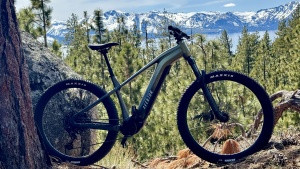 Aventon Ramblas best value electric mountain bike for budget-conscious riders
Aventon Ramblas best value electric mountain bike for budget-conscious riders
80
OVERALL SCORE
- Downhill Performance 7.0
- Climbing Performance 7.0
- Measured Effective Range 9.0
- Power Output 10.0
- E-Bike Controls 8.0
REASONS TO BUY
Fantastic value
Impressive range
Incredibly powerful
REASONS TO AVOID
Fairly heavy
Non-adjustable fork
Tail lights?
SPECIFICATIONS
| Wheel size (inches) | 29 |
|---|---|
| Battery Size (Wh) | 708Wh |
| Motor System | Aventon A100 |
| Motor Power (torque) | 100Nm |
| Measured Weight (w/o pedals) | 54 lbs (Large) |
Aventon, not traditionally known for mountain bikes, enters the trail scene with the new Ramblas and its Aventon A100 motor, offering the best bang for the buck among electric mountain bikes. The Ramblas is impressively specced and priced. It features a RockShox 35 Silver fork, SRAM NX Eagle drivetrain, SRAM DB8 brakes, a dropper post, and Maxxis tires. A removable 708Wh downtube battery powers the torquey motor. It’s the least expensive e-MTB we’ve tested and the most powerful, registering over 26Nm of torque at the ground in dynamometer tests. Lead tester Joshua noted, “Most E-MTB models climb at about the same rate in turbo. The Ramblas just smoked them all.” An aluminum frame, 29″ wheels, a 130mm coil-sprung fork, and slightly conservative modern geometry make it highly versatile. Many will be drawn to the specs alone, but the bike is more than parts. It’s remarkably fun and powerful; even against other e-bikes, the Ramblas excels in cross-country terrain. The direct-to-consumer model yields significant savings, and Aventon targets a broad market with four sizes, the smallest using 27.5″ wheels for riders down to 5’1″.
The Ramblas ride quality isn’t plush due to the non-adjustable fork and non-tubeless compatible rims, which might deter aggressive trail riders. However, it extends beyond trail riding, equipped with tail lights, a bright headlight, and a kickstand mount, appealing to riders seeking mountain bike capability with added versatility. Weighing 54 lbs, it’s not light, but the ample power compensates. In range testing, the Ramblas covered 30.1 miles with 5980 feet of climbing on a single charge. Powerful, capable, and well-priced, the Ramblas is a standout value electric mountain bike.
Read more: Aventon Ramblas review
Aventon Ramblas provides spectacular value as the best bang for the buck electric mountain bike, offering versatility and power.
Credit: Matt Lighthart
Best Lightweight e-mountain bike
Specialized Turbo Levo SL Comp
76
OVERALL SCORE
- Downhill Performance 9.0
- Climbing Performance 8.0
- Measured Effective Range 6.0
- Power Output 6.0
- E-Bike Controls 10.0
REASONS TO BUY
Trail bike ride quality
Excellent integration
Lightweight
Optional range extender battery
REASONS TO AVOID
Pricey
SPECIFICATIONS
| Wheel size (inches) | MX (29″ front, 27.5″ rear) |
|---|---|
| Battery Size (Wh) | 320Wh (+160Wh Range Extender) |
| Motor System | Specialized SL 1.2 (320W) |
| Motor Power (torque) | 50Nm |
| Measured Weight (w/o pedals) | 40 lbs 1 oz (S4)(2lbs 6 oz – range extender battery) |
The redesigned Specialized Turbo Levo SL Comp is a mid-powered electric trail bike that rides more like a traditional trail bike, earning it the title of best lightweight electric mountain bike. Built with Specialized’s next-gen SL 1.2 motor and a 320Wh battery, it enhances rides with added power, speed, and torque. The motor’s 50Nm torque is less forceful than the standard Levo’s 90Nm, but the Levo SL strikes a balance of assist and weight, being over 5 pounds lighter than the similarly priced alloy Trek Fuel EXe 8 GX AXS Transmission. These two are prime competitors in the mid-power trail bike category, sharing remarkable similarities. The Specialized wins for its lighter weight, exceptional adjustability, and user interface. It excelled in downhill testing; its slacker (and adjustable) headtube angle improved high-speed performance, and shorter 432mm chainstays provided a poppy, agile feel. Its lighter weight in technical situations offers a spryness absent in most e-MTBs. Power delivery feels natural, enhancing rider athleticism on climbs without eliminating effort. Its lower power output is intentional, providing 320 watts in Turbo mode to change ride dynamics while still engaging cardio.
The FACT 11M carbon frame and Fox suspension offer a comfortable, responsive ride. The SRAM drivetrain is suitable for the price, and while the Transmission drivetrain is more precise, it’s not worth the $2000 price jump. This build hits a performance-for-dollar sweet spot. An alloy model is available but is heavier and not significantly cheaper. We also tested it with a 29″ rear wheel for a more efficient, less playful feel. At just over 40 pounds, testers loved its lightweight feel, enabling excellent rides even without power assist.
Read more: Specialized Turbo Levo SL Comp review
Specialized Turbo Levo SL Comp: a fantastic trail bike that happens to be the best lightweight electric mountain bike.
Credit: Matt Lighthart
Compare Products
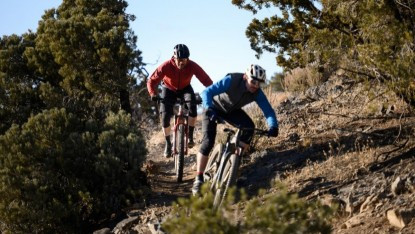 Group of riders testing and comparing best electric mountain bikes on a sunny trail.
Group of riders testing and comparing best electric mountain bikes on a sunny trail.
Out for a rip while testing the best new electric mountain bikes in varied terrain.
Credit: Laura Casner
How We Test Electric Mountain Bikes
Our team of professional mountain bike testers spent months evaluating each electric mountain bike in our selection across diverse trails and climates. Each tester rode each bike extensively, often back-to-back for direct comparison. We subjected them to rigorous testing to identify strengths and weaknesses.
Our testing uses five rating metrics:
- Downhill Performance tests (30% of overall score weighting)
- Climbing Performance tests (25% weighting)
- Distance Range tests (25% weighting)
- Power Output tests (15% weighting)
- E-Bike Controls tests (5% weighting)
Our protocol involves a multi-point performance analysis, ranking both mountain bike and e-bike capabilities. We’ve ridden these bikes hundreds of miles, conducting numerous tests to assess and compare performance. Downhill performance is the most critical metric for mountain e-bikes, weighted at 35% of the total score, reflecting its importance in mountain biking functionality.
Why Trust GearLab
Our testing team comprises bike industry veterans: racers, mechanics, shop owners, and adventure enthusiasts passionate about all aspects of cycling.
Joshua Hutchens has decades in the bike industry as a racer, shop owner, mechanic, and guide. He teaches mountain biking and critically assesses bike performance, enjoying air time on trails like Highline in Sedona and A-Line in Whistler. Jeremy Benson, mountain biking since 1992, raced bikes from 1999 and continues racing in Tahoe, achieving top results in events like the Downieville Classic. He authored Mountain Bike Tahoe in 2017. Kurt Gensheimer, a bike industry veteran and freelance writer, brings decades of testing expertise and explores remote areas like the Lost Sierra on e-MTBs. He is also known as the Angry Single Speeder. Chris McNamara, a rock climber turned mountain biker, loves long-distance rides and is planning routes around Lake Tahoe and from Canada to Cabo San Lucas.
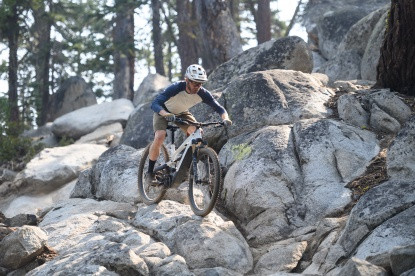 Electric mountain bike testing on moto legal trails near Lake Tahoe, CA by GearLab testers.
Electric mountain bike testing on moto legal trails near Lake Tahoe, CA by GearLab testers.
GearLab team testing electric mountain bikes on moto legal trails near Lake Tahoe, CA, showcasing real-world testing conditions.
Credit: Laura Casner
How to Choose the Best Electric Mountain Bike
Finding the ideal bike is challenging, and adding a motor can seem daunting. We aim to guide you through the options and highlight key considerations to simplify your buying process for the best electric mountain bike.
Lightweight or Full Power Electric Bike?
Full-power e-MTBs feature larger 700-900Wh motors with 80-90Nm torque, suitable for long rides, steep climbs, or riders needing extra assistance.
Lightweight e-MTBs offer subtle pedal assist with smaller batteries (320-430Wh), enhancing handling and agility. Their sleeker design provides a more natural, acoustic-bike-like ride experience.
Consider your riding group’s bikes and your riding goals. Do you prioritize range and maximum laps, or a natural, playful feel? Your preferences and typical riding habits will guide you toward the appropriate e-MTB type.
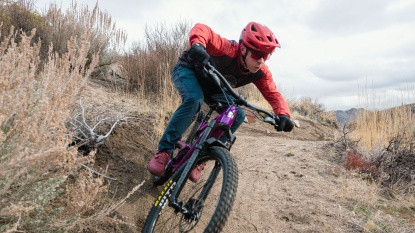 Riders enjoying both lightweight and full-power electric mountain bikes on varied terrain.
Riders enjoying both lightweight and full-power electric mountain bikes on varied terrain.
Whether lightweight or full-power electric bike, you are bound to have a good time exploring trails.
Credit: Matt Lighthart
Frame Material
Like standard mountain bikes, e-bikes come in alloy or carbon frames. Carbon offers lighter weight and vibration damping, significant for e-MTBs. Carbon frames reduce weight around the downtube and motor area, but are pricier. Weight-conscious riders may find carbon worthwhile, while alloy is more affordable and durable against scratches.
Which Wheel Size is Right for You?
Most e-MTBs use 29″ wheels for stability and rollover, but some offer mullet setups (29″ front, 27.5″ rear). Wheel size choice depends on the bike, as not all models offer both variations. Some bikes have flip chips to accommodate different rear wheel sizes. Mullet bikes offer geometry changes, with shorter chainstays enhancing playfulness and agility. Decision depends on preference for stability vs. lively handling.
Lively and playful or controlled and balanced, finding the right wheel choice is up to you for the best electric mountain bike experience.
Credit: Abriah Wofford
How Much Travel Do You Need?
Bike travel categorizes riding capabilities. Under 140mm travel suits cross-country and trail riding, ideal for long rides. 140-160mm is most popular for e-MTBs, offering a balance. Over 160mm is for downhill-focused riding. Most e-MTBs fall in the all-mountain category (140-160mm), balancing uphill and downhill performance. Well-designed e-MTBs allow for more travel without compromising uphill ability due to motor assist.
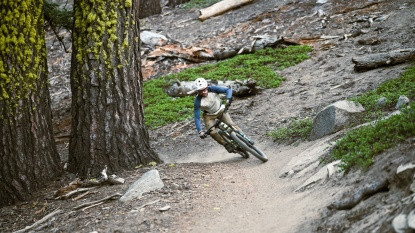 Rider choosing the right travel for their electric mountain bike based on terrain and riding style.
Rider choosing the right travel for their electric mountain bike based on terrain and riding style.
Choosing the right travel for your best electric mountain bike depends on your terrain and riding style, with advancements in geometry and design making it easier than ever to find the perfect match.
Credit: Abriah Wofford
Analysis and Test Results
We rigorously assessed each e-bike’s performance across downhill, climbing, range, power output, and controls to provide insights for your e-bike buying quest.
When we test bikes, we push them to their limits and ride them extensively to understand handling and performance nuances for the best electric mountain bike recommendations.
Credit: Abriah Wofford
What’s the Best Value?
Mountain bikes are expensive, and e-motors increase the cost. Pricier e-MTBs are often higher-performing, but exceptions exist. The Aventon Ramblas offers near-top performance at a lower price due to direct-to-consumer sales. Similarly, the YT Decoy 29 Core 4 and Canyon Spectral:ON CF8, with carbon frames and great builds, offer exceptional trail performance for their price, costing less than comparable bikes from larger brands.
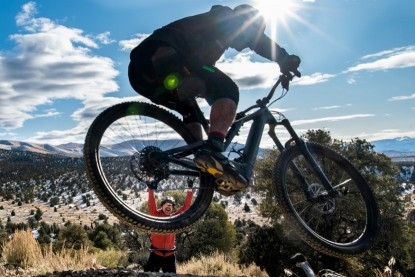 Sharing the stoke and camaraderie during electric mountain bike testing sessions.
Sharing the stoke and camaraderie during electric mountain bike testing sessions.
Sharing the stoke is an integral part of e-bike testing, ensuring we evaluate the Best Electric Mountain Bikes with enthusiasm.
Credit: Laura Casner
What is an E-Bike?
Electric bikes vary in types and classifications. Most e-MTBs are Class 1, providing power only while pedaling, limited to 20 mph in the US. These resemble mountain bikes but integrate batteries and motors into the frame. The motor, typically near the bottom bracket, offers pedal assist, amplifying rider input. Systems offer support settings to vary assistance levels.
We tested full-suspension all-mountain/trail models with similar suspension travel, geometry, and wheel/tire size. E-bikes, with batteries and motors, weigh around 50 lbs, about 20 pounds heavier than non-e-bikes. This weight makes them harder to ride without motor assist, except for lighter models like the Trek Fuel EXe (around 45 lbs).
E-MTBs are legally and responsibly rideable in many US areas, offering significant fun. Check local land management for e-MTB trail access. E-MTBs are allowed on motorized trails, which we utilized in the Lake Tahoe area for testing.
Adding motors, batteries, and controls increases potential component issues. Research warranty coverage and buy from local dealers for support if problems arise with your electric mountain bike.
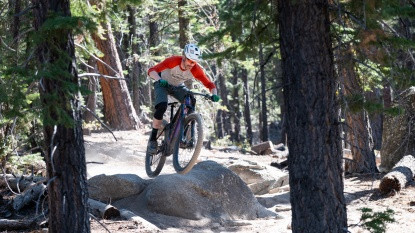 Modern electric mountain bikes like the Trek Rail 9.7 descending a technical trail.
Modern electric mountain bikes like the Trek Rail 9.7 descending a technical trail.
Modern electric mountain bikes like the Trek Rail 9.7 perform very well on the descents, enhancing the trail riding experience.
Credit: Laura Casner
Downhill Performance
Downhill performance is our top rating metric because trail performance, especially downhill, is crucial for e-bikes. Testers rode each bike extensively on varied terrain, from fast flow trails to technical sections, assessing component spec, geometry, and frame design.
The Trek Fuel EXe was a tester favorite for versatile downhill performance, feeling “a lot like a regular trail bike.” Its light weight and nimble handling, with 140/150mm travel, offer capability and playfulness, though not the most aggressive, it’s the best handling and feels most natural. The full-power Turbo Levo Comp was another downhill favorite with 150/160mm travel, balanced weight, and responsive handling, confidently tackling diverse trails. Its adjustable geometry allows riders to customize handling to their style and terrain, making it a highly adaptable best electric mountain bike.
The Turbo Levo Comp’s adjustable geometry allows riders to make dramatic changes to suit their needs and preferences for optimal downhill performance.
Credit: Abriah Wofford
The Santa Cruz Heckler SL combines 150/160mm travel, modern geometry, and mixed wheels for versatile, lightweight performance across speeds and terrain. It’s stable at speed and in steep terrain, yet maneuverable at lower speeds and on moderate trails. The Canyon Spectral:ON CF 8 with moderate geometry and 155/150mm travel, offers well-rounded downhill performance. Surprisingly nimble for its weight, it remains stable and confidence-inspiring at high speeds and on steep trails, handling challenging terrain effectively.
YT’s Decoy 29 impressed with versatile downhill performance. With 145mm rear travel, 29″ wheels, and moderate modern geometry, it’s a capable descender comfortable on varied terrain. Like the Trek Fuel EXe and Specialized Levo, it feels like a responsive trail bike, agile and capable when trails get demanding, making it a versatile best electric mountain bike option.
 YT Decoy 29 versatile model excelling in downhill performance and ready for any trail.
YT Decoy 29 versatile model excelling in downhill performance and ready for any trail.
The YT Decoy 29 is a super versatile model that won’t hold you back on the descents, ready for anything the trail throws your way.
Credit: Laura Casner
The Commencal Meta Power TR Ride was also enjoyable downhill. Its long, slack enduro-like geometry felt great at speed and on rough terrain, while also being fun on flow trails and mellower terrain. The Trek Rail 9.7, a 150mm 29er with modern geometry, impressed with its planted, ground-hugging feel and eagerness to accelerate. The Rail’s flip-chips allow geometry adjustments for different terrain or preferences.
Pedal assistance on the best electric mountain bikes makes climbs easier, and in some cases, just as fun as the descents.
Credit: Laura Casner
Climbing Performance
E-bikes aim to ease uphill riding. Some testers find climbing nearly as fun as descending with pedal assist. Climbing on an e-MTB differs from non-motorized bikes; they ascend quickly, prioritizing power and momentum over finesse. Their weight provides traction, keeping them planted, and suspension compression/climbing switches can be left open for added traction. Geometry, handling, and power output influence climbing performance, tested extensively during uphill laps for more downhill runs to evaluate the best electric mountain bikes for climbing.
The YT Decoy 29 Core 4 is a very competent climber. Its powerful Shimano EP8 motor and dialed trail geometry contribute to comfortable and maneuverable climbing, handling varied trail conditions effectively. The Specialized Turbo Levo Comp is another uphill favorite, with a powerful motor and geometry suited for scrambling up diverse climbs while maintaining maneuverability. Its adjustable geometry further customizes handling, enhancing its climbing performance as a top electric mountain bike.
 Trek Rail powering up and over obstacles, showcasing climbing capability of electric mountain bikes.
Trek Rail powering up and over obstacles, showcasing climbing capability of electric mountain bikes.
The Trek Rail isn’t exactly agile, but it is plenty capable of powering up and over anything in its path, making it a strong climber among electric mountain bikes.
Credit: Laura Casner
The Canyon Spectral:ON CF 8 also climbs well. Its moderate trail geometry and powerful EP8 motor enable blasting up challenging climbs. Similarly, the YT Decoy, using the same motor and dialed geometry with supportive 4-bar suspension, makes climbing nearly as enjoyable as descending. Its smaller rear wheel and balanced weight enhance maneuverability despite its heavy, long e-bike nature.
The Trek Fuel Exe and Specialized Levo SL were the most agile climbers. Line choice is crucial, unlike full-power bikes where you can point-and-shoot. Flip-chips allowed geometry adjustments, with the high setting better for climbing and trail riding, and low settings for fast descents.
The Turbo Levo SL doesn’t pack the same punch as the full-power models but its lighter weight and middle-of-the-road geometry handle well on the climbs, suitable for riders prioritizing agility.
Credit: Laura Casner
The Santa Cruz Heckler SL is an outlier in climbing. With less power and torque than full-power models, climbing requires more effort, despite not being significantly lighter. However, it has comfortable geometry, quick handling, and no drivetrain drag. Riders who prefer working harder will enjoy the Santa Cruz for its balanced climbing and downhill capabilities as a versatile electric mountain bike.
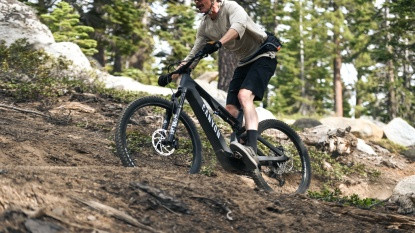 Spectral:ON downtube housing a 900Wh battery for longest range among tested electric mountain bikes.
Spectral:ON downtube housing a 900Wh battery for longest range among tested electric mountain bikes.
The wide downtube of the Spectral:ON houses a whopping 900Wh battery that gives it the longest range of any model we’ve tested, making it ideal for extended rides.
Credit: Abriah Wofford
Distance Range
E-MTB distance range is how far you can ride on a charge, influenced by battery capacity (typically 625-700Wh, some 900Wh), rider weight, pedaling input, terrain, conditions, and temperature. Larger batteries theoretically offer longer range, but variables affect battery life.
To compare range, we had a tester ride each bike in its highest support setting on a similar course until battery depletion, recording distance and elevation gain. Garmin power meter pedals monitored rider input to equalize effort.
The Canyon Spectral:ON CF 8, with a 900Wh battery, had the longest range, riding 38.5 miles with 5,292 feet of elevation change. Real-world rides of 30+ miles with over 6,000 feet of climbing were easily managed without battery concerns, establishing it as the best electric mountain bike for range.
Want to go on long rides with lots of vert? The Turbo Levo Comp and its 700Wh battery is a good choice for extended adventures.
Credit: Abriah Wofford
The Turbo Levo Comp, with a 700Wh battery (fitting in the space of older 500Wh batteries with only 2 lbs added weight), performed competitively in range testing, covering 33.1 miles and over 5,000 vertical feet. Trail rides of 30+ miles with 6k vertical were achievable before battery drain.
The Commencal Meta Power TR, with a 630Wh battery and Shimano EP8 motor, traveled over 26 miles with nearly 5,000 vertical feet. Trail rides of 30 miles with 6k climbing were also achieved. The Trek Rail 9.7, with a 625Wh battery, impressively traveled 28.95 miles, despite having less battery capacity than the Levo.
The Aventon Ramblas, with a 708Wh battery and A100 motor, logged 30.1 miles and 5980 feet of ascent. The YT Decoy 29 Core 4, with a 540Wh battery, achieved 23.2 miles, a relatively impressive result given its smaller battery. Rides over 24 miles and 4,000+ vertical feet were possible with some battery reserve.
The Range Extender battery fits into the bottle cage of the Levo SL adding 160Wh to the 320Wh internal battery, increasing range for longer adventures.
Credit: Laura Casner
The Trek Fuel EXe, with a 360Wh battery, had the shortest range, covering 19 miles and 1700 vertical feet on high power. However, in Eco mode, rides over 30 miles with 5,000+ vertical feet were possible.
Lower power output usage increases range. Drive unit smartphone apps customize support settings for range optimization. Specialized’s Mission Control app allows route-based power regulation and heart rate-based assist adjustment for maximizing range, making it a smart electric mountain bike system.
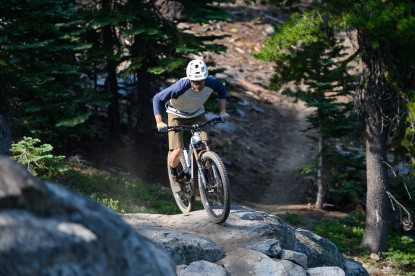 Different motor systems on electric mountain bikes offering varied performance characteristics.
Different motor systems on electric mountain bikes offering varied performance characteristics.
The different motor systems are all pretty good but differ slightly, with the new Shimano EP8 on the Decoy 29 working very well in power delivery and efficiency.
Credit: Laura Casner
Power Output
E-bike motors provide pedal assist. Systems function similarly, but subtle power output differences create varied feels. All systems work well; differences are generally minor. We tested power output based on feel in blind tests, with testers discerning differences. All tested e-bikes are Class 1, 20 mph max assist, with support modes.
The Specialized 2.2 motor system (90Nm torque, 565 watts peak) felt slightly more powerful than others, except for the Aventon Ramblas. The Ramblas’ A100 motor delivers remarkable power, conquering challenging climbs. The A100 is advertised at 100Nm torque, making it a powerhouse among electric mountain bikes.
Shimano’s EP8 motor, found on the Canyon, YT, Santa Cruz, and Commencal, works great and provides plenty of power for blasting around the trails.
Credit: Abriah Wofford
Despite an 85Nm torque rating, the Bosch Performance CX motor on the Trek Rail 9.7 felt among the most powerful, with smooth, consistent, and strong power delivery. The new Shimano EP8 motor on the Commencal Meta Power TR, Canyon Spectral:ON CF 8, and YT Decoy 29 Core 4 (85Nm torque) felt powerful with smooth, consistent delivery, but slightly less forceful than the Bosch. The Shimano E-Tube app allows output customization.
The Trek Fuel EXe differs from others. Its TQ HPR-50 motor (50Nm torque, 300 Watts max) has about half the power, intentionally. Power output is smooth but less forceful, requiring more rider effort, preferred by some. The Santa Cruz Heckler SL uses the Fazua Ride60 motor (60Nm torque), feeling less punchy than the Trek’s TQ motor, offering a different power profile for varied rider preferences in electric mountain bikes.
Handlebar-mounted control unit on the Trek Rail 9.7 for easy access and adjustments during rides.
The top tube-mounted display on the Trek Rail 9.7 is pretty slick, although it can be hard to view while riding, a trade-off for its clean integration.
Bosch interface with control unit by the left grip and a small bike computer-style display for Trek Rail 9.7.
E-Bike Controls
E-bike controls vary across motor systems. We rated user-friendliness, shifter ergonomics, display readability, and charging ease. Smartphone apps for motor setting customization, battery monitoring, etc., are available but not essential.
The Commencal Meta Power TR Team scored well in controls, with a stem-mounted digital display, ergonomic Shimano shifter, and readable SC-EM800 display. The YT Decoy 29 and Canyon Spectral:ON CF 8 have similar controls and displays, with easy-to-reach controls and stem-mounted digital displays, but the E7000 display lacks color-coded output settings of the Commencal. Output settings are customizable via the Shimano e-Tube app for personalized feel and power, enhancing the user experience of these electric mountain bikes.
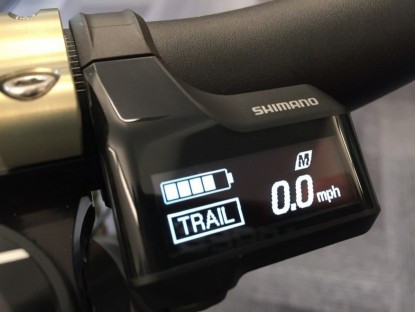 Shimano E7000 display on electric mountain bike, compact but functional for essential ride data.
Shimano E7000 display on electric mountain bike, compact but functional for essential ride data.
The Shimano E7000 display, it may be small and somewhat hard to read, but it’s far better than no display at all for monitoring e-bike functions.
Credit: Jenna Ammerman
Trek’s Rail 9.7 features a Bosch Kiox display and controls. Controls are intuitive but less ergonomic. The top tube display is visually appealing but hard to see while riding and somewhat complex. Customizable display features exist but were not fully explored. The Specialized Turbo Levo Comp scored lower in controls due to lacking a handlebar display. Controls are ergonomic, but the top tube LED display is less readable while riding, though functional. Newer Bosch controllers are wireless for a cleaner cockpit look, improving the aesthetics of electric mountain bikes.
E-bikes are a ton of fun to ride. Some are better than others, and our review helps you find the best electric mountain bike for your needs.
Credit: Jenna Ammerman
Conclusion
Many excellent electric mountain bikes are available, with growing options. Choosing the best e-MTB for your needs can be challenging. This comparative review aims to help you find the best model for your riding style, terrain, and budget. We will continue updating this review as new electric mountain bikes emerge and technology evolves, ensuring you have the latest information to make informed decisions in the dynamic world of electric mountain bikes.
For complete bike outfitting, we’ve also tested great bike gear including mountain bike shoes, mountain bike helmets, and more to enhance your riding experience.

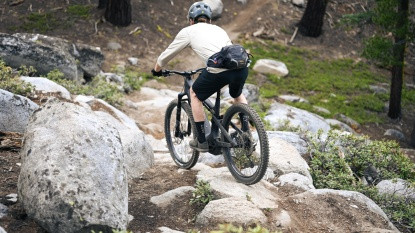 Riders choosing between lively and playful or controlled and balanced wheel sizes on their electric mountain bikes.
Riders choosing between lively and playful or controlled and balanced wheel sizes on their electric mountain bikes.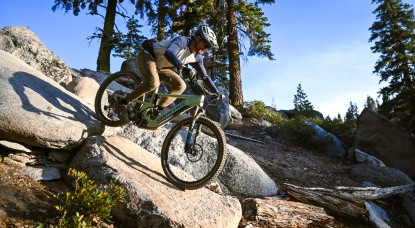 Electric mountain bike testing to the limits on challenging trails to tease out handling and performance differences.
Electric mountain bike testing to the limits on challenging trails to tease out handling and performance differences.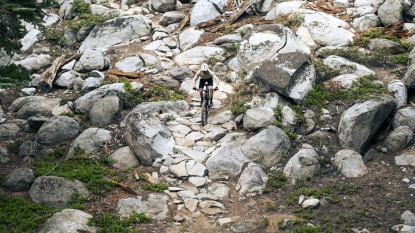 Turbo Levo Comp adjustable geometry allowing riders to customize their best electric mountain bike for varied terrains.
Turbo Levo Comp adjustable geometry allowing riders to customize their best electric mountain bike for varied terrains.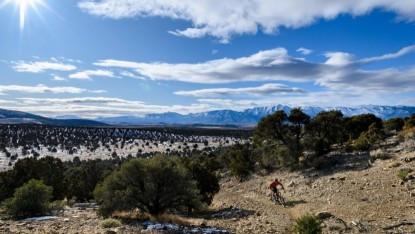 Pedal assistance making climbs easier and almost as enjoyable as descents on electric mountain bikes.
Pedal assistance making climbs easier and almost as enjoyable as descents on electric mountain bikes.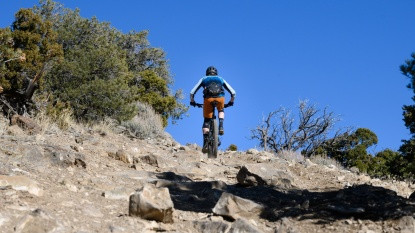 Turbo Levo SL lighter weight and geometry handling climbs effectively as a lightweight electric mountain bike.
Turbo Levo SL lighter weight and geometry handling climbs effectively as a lightweight electric mountain bike.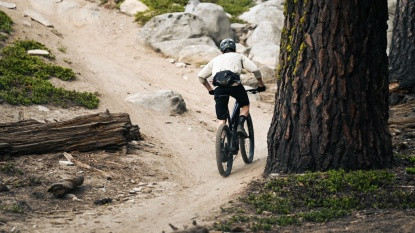 Turbo Levo Comp 700Wh battery for long rides and vertical gains, a strong contender for best range e-MTB.
Turbo Levo Comp 700Wh battery for long rides and vertical gains, a strong contender for best range e-MTB.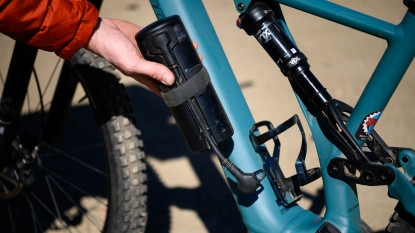 Levo SL range extender battery adding 160Wh to the internal 320Wh battery for extended rides on a lightweight e-MTB.
Levo SL range extender battery adding 160Wh to the internal 320Wh battery for extended rides on a lightweight e-MTB.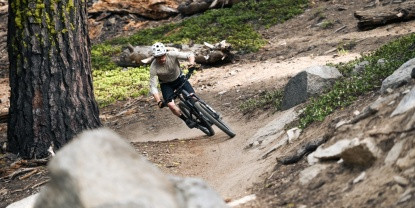 Shimano EP8 motor providing ample power for trail riding on Canyon, YT, Santa Cruz, and Commencal e-MTBs.
Shimano EP8 motor providing ample power for trail riding on Canyon, YT, Santa Cruz, and Commencal e-MTBs.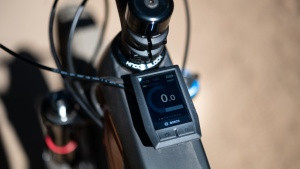 Top tube-mounted display on the Trek Rail 9.7 providing sleek integration but can be harder to view while riding.
Top tube-mounted display on the Trek Rail 9.7 providing sleek integration but can be harder to view while riding.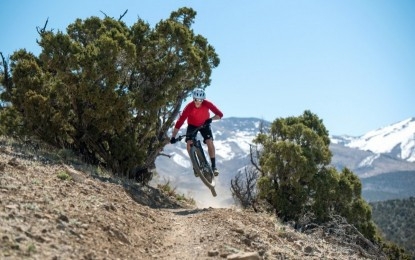 E-bikes are a ton of fun to ride, offering an enjoyable experience on trails, but some models stand out.
E-bikes are a ton of fun to ride, offering an enjoyable experience on trails, but some models stand out.